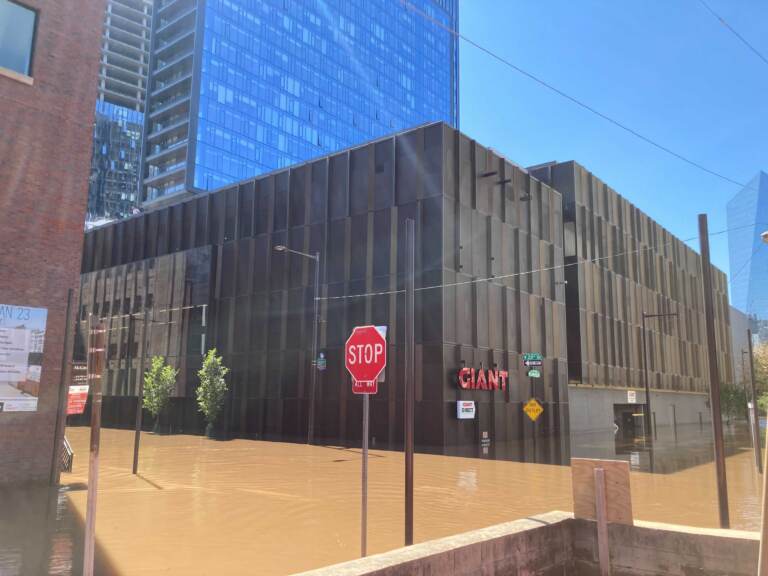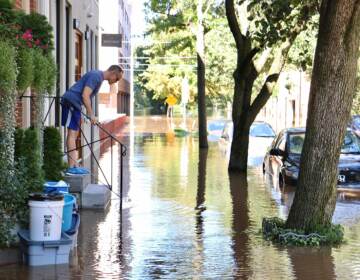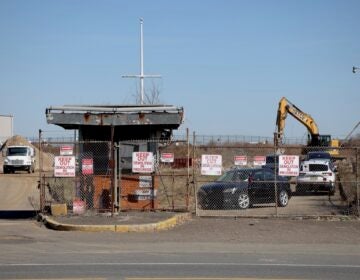Why did new buildings flood in Philly? Outdated FEMA maps and building code
Developers are building new homes according to outdated regulations, according to Philadelphia flood czar Joshua Lippert.

The Riverwalk development opened on the Schuylkill River in Logan Square this year. It flooded in Ida’s aftermath. (Ryan Briggs / WHYY)
A lake of muddy brown stormwater filled the intersection of North 23rd and Arch streets, swamping the corner’s glass-walled Giant supermarket and the gleaming new Riverwalk apartment tower above.
Marooned tenants occasionally emerged onto the entrance patio and stood gazing across the rippling murk. Late Thursday afternoon, a resident who had been ferried across the pond by a Coast Guard boat paced the muddy upslope of 23rd Street, complaining bitterly about the building management. Their inadequate preparation for the remnants of Hurricane Ida the previous night was the latest in a series of missteps since he moved in a few months ago, he said.
“They said the construction would be done by this date. The construction is still not done today,” said the man, who declined to give his name for fear of retaliation from his landlord. “So the flooding was definitely not even mentioned. A lot of people are very, very upset.”
“The building is not prepared for anything, let alone a disaster like this,” he said.
Those stuck inside had not heard anything from the building manager until 2:36 p.m., when an email announced the company was in the process of getting a boat, he said. “We will be picking up beer and snacks and hosting a ‘flood’ party that will be set up in the lounge area,” the message read. Executives at the management company, PMC Property Group, did not respond to messages seeking comment.
Having watercraft at the ready in case of flash floods may be a lot to expect from a landlord. But the need for boat rescues at the Riverwalk building, in Manayunk, and at other sites along the Schuylkill River last week illustrates both the unusual severity of last week’s floods and the challenge of designing and operating buildings that can withstand the region’s increasingly intense and frequent storms.
In recent years, city officials have stepped up their efforts to educate developers and architects about floodproofing requirements for construction in floodplains along the Schuylkill and other parts of Philadelphia, and to ensure building plans comply with regulations.
But the FEMA flood maps that determine where homes can be built and how high they must be elevated are badly out-of-date. Developers rarely volunteer to alter their plans to incorporate newer data or the effects of climate change, which has already raised sea levels in the region and heightened flooding risk, said Joshua Lippert, the city’s floodplain manager.
“Floodplain maps by FEMA are dated the day they become effective. The 2007 map for the Schuylkill River is actually data from the late 1990s, so it’s extremely dated. There is a lot more risk that is potentially greater than shown on some of those products,” Lippert said.
“Developers want to meet the minimum requirements. They might have intentions to do more, but ultimately the city is only holding them accountable to the minimum requirements. The way the program is developed today does not incentivize higher standards or more resilient practices,” he said.
Water rising to the doors
Some developers have worked to subvert the outdated restrictions that do exist. Venice Island in Manayunk has been flooding regularly for 150 years, yet since the 1990s builders have been successfully fighting off lawsuits by neighborhood groups and objections from city planners in order to put up one residential development after another. In 2000, then-FEMA director James L. Witt said he viewed the construction proposals “with alarm” and warned that “future flooding is a certainty” on the island.
By 2008, a developer who submitted new data to FEMA was able to get large portions of Venice Island redesignated from a floodway, where development is barred, to a floodplain where new buildings are allowed if they are elevated above a specified baseline, Lippert said. Subsequently, in 2010 and 2014, floods damaged properties on the island and forced evacuations by boat.
Yet, in 2018, Philadelphia City Council approved a rezoning to allow another townhouse development called The Locks. Councilman Curtis Jones, the zoning bill sponsor, said he was confident “we will build in proper measures to get on and off that island” during floods. An additional FEMA redesignation affecting much of the rest of Venice Island was approved in 2019 despite an appeal by the city, Lippert said.
Fears were realized last year when flooding from Tropical Storm Isais drove island residents from their homes and scoured the first floor of units in the Apex Manayunk development despite floodproofing efforts. Then, last week, emergency personnel were out on the Schuylkill in boats yet again. “The Philadelphia Fire Department made numerous rescues and evacuated both people and pets from properties on Venice Island,” a city spokesperson said.
The swollen Schuylkill covered much of the island and swamped the non-residential first floor of The Isle apartment complex. It also swallowed up the land around newly completed units of The Locks, which were built atop 10 feet of fill as a flood mitigation measure. The water rose nearly to the doors of the living units themselves.
“It was crazy. People were standing there, opening their doors, and there’s water all around them,” said Darlene Messina, a longtime Manayunk resident who observed the inundation from across the canal.
Messina was part of a group that spent years battling developer Carl Dranoff in the 1990s and early 2000s in a failed effort to prevent construction of housing on the island. She sees last week’s flooding as one more piece of evidence that development there has been a disaster.
Messina argues that building up the height of the floodplain blocked a path for stormwater, squeezing it into a narrower channel and increasing its height both on the island and along Main Street in Manayunk during storms. That has increased the burden on the Fire Department and other city agencies while intensifying the harm to residents and business owners, she says.
“FEMA allows development in the floodplain, but from what we know right now about weather systems, nobody should be building in the floodplain,” she said. Messina is a program manager for FEMA’s National Dam Safety Program but said she was speaking on her own behalf.
Designing for resilience
Developers and some elected officials disagree with arguments that development in floodplains is too risky. They contend that major floods are rare and that repeated successful evacuations actually show that buildings in flood-prone areas meet safety guidelines while satisfying demand for housing in scenic riverside neighborhoods. When Dranoff’s Venice Lofts apartments were evacuated by raft in 2010, he told the Inquirer, “The buildings are performing exactly as planned. Every precaution was taken in the design of the buildings. There’s no harm to people.”
Lippert agreed that good building design, combined with use of flood insurance policies, can mitigate the risks from storms. New structures in flood zones often have “wet” floodproofing, with entryways, garages, and storage spaces on the ground floor that can handle occasional inundation without incurring structural damage. He cited a cluster of new townhomes PMC recently built across the street from its Riverwalk complex.
“You’ll see flood vents on the front and the rear of those structures, across the garage door and in the front of the structures as well. That’s a great example of areas that are designed to have water come in and come out. You just hose them off and then you should be great,” said Lippert, who was hired as Philadelphia’s first floodplain manager in 2018.
He noted that the design does not protect objects on the ground level, as shown by the submerged cars in a number of riverside parking garages. “When you get a warning, you don’t just leave your car in those areas that have flood vents. You would move it to higher ground. Unfortunately, I don’t think there’s enough potential education or understanding of that when you’re located in the floodplain,” Lippert said.
Some commercial structures that are required to have “dry” floodproofing use waterproof gates, which are put in place around a building before a storm to create a bathtub effect. Both the Riverwalk tower and the Aramark building a few blocks to its south have gate systems, but at both buildings the gates appear not to have been installed before last week’s storm, Lippert said. The Aramark building is co-owned by PMC and Lubert-Adler Real Estate Funds, and houses the swanky Fitler Club hotel and spa on its lower levels.
Dry waterproofing can work, but only if the building management acts quickly to install the gates, which can be a laborious process. Scott Erdy, a Northern Liberties-based architect who has designed flood-mitigated buildings in the Navy Yard and Hoboken, as well as the rain-absorbing Cira Green rooftop park in West Philadelphia, said he’s currently working on a residential building in Hoboken with façade panels that can be lowered into place like garage doors.
“We’re trying to incorporate them as part of the architecture so they’re visible,” he said. “On a cruise ship, everybody sees the lifeboats all day long and knows where they are. If the lifeboats are down in the bottom of the basement and there’s a big emergency, no one’s going to know where they are. I really want people to see and understand these resilience issues, not just when there’s a hurricane.”
Erdy, who is also a visiting lecturer in architectural design at the University of Pennsylvania, said local architects and developers are very willing to be proactive about flood resiliency and sustainability generally in their buildings. That’s in part because potential tenants want those features, he said.
“A lot of clients now are more educated on this issue and they ask for these things,” Erdy said. “If you’ve got a big company that’s got corporate shareholders and they’re going to choose between this building which is not environmentally sustainable versus one that is, that’s another selling point. Public awareness is key.”
But Erdy and Lippert both said there are limits to the power of building design. Despite the perception that last week’s storm was unusually rare and intense, the flooding actually matched predictions on FEMA maps and a similar event could occur again next month or next year, Lippert said. He said federally subsidized insurance partially shields landlords and residents from the full economic impact of flooding, but the sheer frequency of indundations in the region may force decision-makers to enact more stringent restrictions on development in high-risk areas.
“There needs to be some kind of ‘come to Jesus’ moment where we really understand the risk and the economics and this pressure to build a tax base,” Lippert said.
“It would be very difficult in an urban city to solve flooding. You can try your hardest to fight back, but especially with climate change and sea-level rise and higher tides, what we build today to ‘solve flooding’ could actually not work in a few years,” he said. “These are natural floodplains, or wetlands, or environmentally sensitive land. It’s where the water wants to go.”

Subscribe to PlanPhilly
WHYY is your source for fact-based, in-depth journalism and information. As a nonprofit organization, we rely on financial support from readers like you. Please give today.









